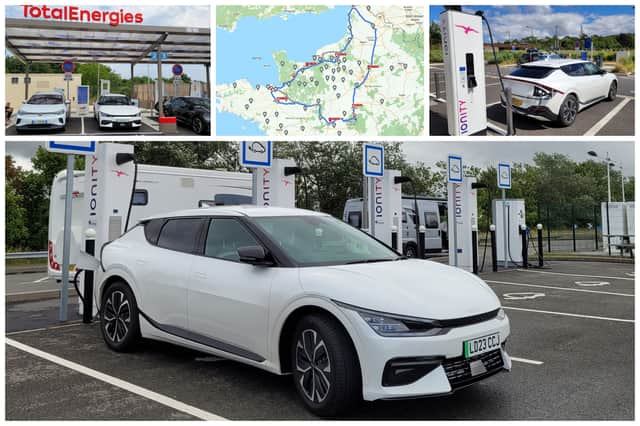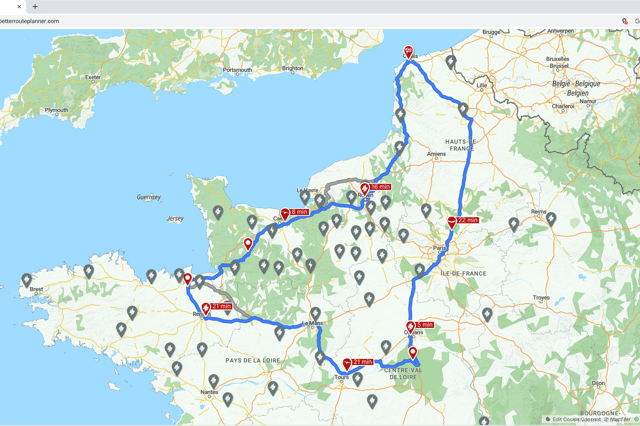Taking an electric car to Europe - all you need to know about driving and charging an EV in France


As more and more drivers opt for an electric car, whether it’s for ecological, tax or practical reasons, many more are going to use them for family holidays, including trips to mainland Europe where the charging landscape is unfamiliar.
The vast majority of British holidaymakers who drive to Europe end up in France and I’m no exception, so this year’s family break seemed the ideal opportunity to get to grips with using and charging an EV in the most common foreign holiday destination.
Advertisement
Hide AdAdvertisement
Hide AdTo help understand with the ins and outs of EV motoring abroad, I turned to my favourite electric car of the moment - the Kia EV6, with its 328-mile WLTP range and ultra-fast 350kW charging capabilities. I also got my hands on a Kia Charge RFID card - provided to every new EV6 owner - which gives a single payment method for more than 550,000 chargers across Europe, and offers discounted rates at many, including 15p/kWh off at Ionity’s ultra-fast units via the £6.90 a month Ionity Power package.
In the past, we’d had the scare stories from the ill-prepared and ill-informed about how horrendous driving an EV through Europe is. But that’s not what this article is about. Firstly, because I found the whole process utterly painless, and secondly, because this is about the practical things you need to know before and during your trip.
A little planning goes a long way
Unless you drive a Tesla (which will do virtually all your route, charging and payment planning for you) you’ll need to spend a little time thinking about your trip in advance, including your route, charging stops and how you’re going to pay for your electricity.
Even before you start planning a route, think about your car’s capabilities and the impact of a long trip. Things like:
Real world range and how the extra weight of luggage and passengers will affect this
How your route will affect range. If you spend most of your time pootling around town, several hours at French autoroute speeds could dramatically affect your car’s energy use
Charging speeds - Our Kia is among the fastest charging cars on sale but if you’re limited to 50kW or 100kW, there’s no point in paying more than necessary for a charger you can’t take full advantage of


Advertisement
Hide AdAdvertisement
Hide AdOnce you’ve done that, it’s a matter of plotting a route to your destination. Most EVs’ onboard navigation, including that on the EV6, isn’t up to the task of planning a long-distance, multi-stop trip. Thankfully there are EV-specific apps out there, of which I found ABetterRoutePlanner to be the best.
On the surface it’s a simple route planner that allows you to add start and end points, plus any waypoints you like. But beneath that it’ll take into account everything from your car’s make and model to how much extra weight it’s carrying and even topography to work out where and when you’ll need to stop, for how long and, in some cases, how much it’ll cost. It will even take into account your preferred charging providers and locations.
It’s Android Auto and Apple CarPlay compatible (for a small fee) or you can just take its stop recommendations and plug them into Google Maps instead, which also bings more reliable traffic updates.
Have a back-up plan
Whatever the route, it’s worth a quick check to see what alternative chargers are available near your planned stop and always yourself a little leeway in terms of charge in case your first choice is busy or broken.
But don’t overthink it
Advertisement
Hide AdAdvertisement
Hide AdWhile planning is important, don’t do what I did and obsess over every route and charger for the whole trip before you set off. Generally things work out okay and if they don’t - because of traffic or using more or less energy than expected, for instance - you’ll be making changes on the move anyway, so hours poring over maps and apps are largely wasted. In such cases, it’s useful to have an app like ABPR or Kia Charge, which can quickly identify other nearby chargers that meet your needs. There are also European-specific ones such as those linked to the Miio network, which covers everywhere from Luxembourg to Portugal.
Charging provision


France, like the UK, is rapidly expanding its charging network but, from my experience, is already some distance ahead. French autoroutes seem far better supplied with the latest and fastest chargers than UK motorways. As well as a huge number of Ionity sites, which we favoured, we found no shortage of Total Energy, Engie, Fastned and other 300kW+ ultra-rapid providers allowing drivers to slip off the motorway, get a brief charge and be on their way again.
Just like the UK, peak times can see them fill up quickly and the weird arrangement of some service areas makes it hard to wait or circle back around. But, on the whole, I found them quieter than UK sites and modern charging speeds mean you should never be waiting for too long, anyway.
That said, it’s worth checking the details of your planned charging locations. Most of ours were in well-served service areas with toilets and shops but we encountered one bank of devices in a largely deserted park and ride facility and another in a hotel car park with a sign firmly pointing out that the hotel facilities were for guests only. Thankfully, 30 seconds down the road was a 16-bay Fastned forecourt beside a full service station.
Advertisement
Hide AdAdvertisement
Hide AdOff major routes, the picture is more mixed but we still found plenty of 50kW+ devices in more rural areas, priced far cheaper than their UK equivalents. These, however, seemed slightly less reliable, either out of service or with no status available via various apps.
Paying for charging
The good news is that, in general, charging is cheaper in France than in the UK. Across a variety of providers, I never paid more than 69 cents per kWh (roughly 60p) for even the fastest charging. Even Ionity’s standard rate is lower on the continent (the equivalent of 56p compared with 74p). In one instance, I even found a 350kW unit charging just 30 cents per kWh, which added 175 miles in 15 minutes for just £11.
French chargers generally accept payment via RFID cards, although most ultra-rapid ones we found also accepted contactless credit cards. Some also use apps or QR codes that direct you to a payment site but we spoke to a couple of British drivers struggling to make such systems work.
If you don’t have access to a manufacturer-linked card like the Kia Charge one (which worked faultlessly) it’s worth signing up in advance to a third-party one like Shell Recharge or Chargemap Pass that offers a single cross-network payment card, which will avoid any issues.
Other things to consider
Advertisement
Hide AdAdvertisement
Hide AdCharge while you shop. It makes sense to charge while you’re busy doing other things and France is well served in this regard. Lidl seems to be on a mission to entice EV owners and every store we encountered had a couple of brand new 120kW units charging just 25 cents/kWh. We also used a Carrefour station with a variety of chargers ranging from 22kW to 300kW and costing just 64 cents.


Remember your clean air sticker. Some French cities, including Paris, Rouen, Lyon and Bordeaux have low-emissions zones. Obviously, your EV is free to drive within them but you’ll need to display a Crit’air sticker. These cost euro 3.72 and need to be ordered in advance from the website of the French government.
Motorways take their toll, literally. There’s a price to pay for the fast, well-maintained and well-serviced autoroutes that cut through France, in the shape of tolls. Sites such as Tollguru will calculate the costs for you but it’s worth factoring them into any holiday budget as they can quickly stack up on long drives.
What I learned
My biggest takeaway from two weeks’ driving around France in an EV was that it was just as easy as last year’s petrol-powered trip. A little more forward planning and the wealth of fast, well situated chargers meant it was no more stressful than finding regular filling stations.
Advertisement
Hide AdAdvertisement
Hide AdA lot of the worry around long trips in EVs is around range and time wasted at chargers. However, travelling with kids and using ultra-rapid chargers, I found our charging stops neatly dovetailed with the usual necessary stops, and by the time we’d been for a pee or grabbed a bite to eat the car was back up to 80% or more and ready to go before we were.
It certainly helps to have something with a big battery and ultra-fast charging - take a bow the Kia EV6 - and a single payment system that works across different networks and countries. Many manufacturers offer their own equivalent of Kia Charge and it’s well worth signing up to for the seamless way it works. Some, such as VW, Hyundai and BMW who are also part of the group behind Ionity, also offer discounted rates, making rapid charging affordable as well as convenient. If you don’t have access to such a service, it’s well worth signing up to one of the other cross-network systems.
Comment Guidelines
National World encourages reader discussion on our stories. User feedback, insights and back-and-forth exchanges add a rich layer of context to reporting. Please review our Community Guidelines before commenting.
